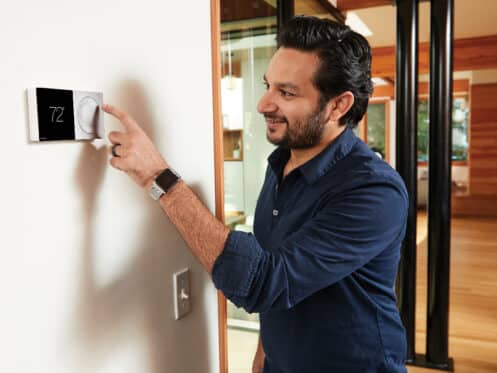For many homeowners, spring means getting your cooling system ready for the hot days of summer ahead. This preparation includes getting your heat pump or air conditioner tuned up by a professional. However, some homeowners forget that ensuring that your thermostat is correctly calibrated is just as important. By fine-tuning your thermostat for the season ahead, you ensure it accurately gauges your indoor temperature, paving the way for optimal comfort and energy savings.
Save Money and Reduce Energy Use
An accurately calibrated thermostat plays a pivotal role in enhancing the energy efficiency of your HVAC system. By ensuring that your heating and cooling systems operate only when necessary, you minimize energy waste and reduce utility bills. Over time, this translates into substantial savings while minimizing your carbon footprint.
Enhance Your Comfort
An inaccurate thermostat will detect temperatures as warmer or colder than your home’s actual ambient temperature. If you set your device at a consistent temperature to reduce energy bills, this may result in an uncomfortable house. Whether it’s the height of summer or a rainy, cold day in spring, precise temperature control ensures that every room remains pleasant.
Extending Your HVAC System’s Lifespan
If your air conditioner or heat pump constantly runs when it’s not needed due to thermostat inaccuracies, it can lead to unnecessary wear and tear on the unit. This thermostat issue presents two problems. One is that it will result in the need for more frequent repairs or even an expensive emergency breakdown. The other is that it may reduce your system’s lifetime and result in the need to replace your air conditioner or heat pump prematurely. A well-calibrated thermostat will ensure your HVAC system does not work harder than it needs to.
Steps to Calibrate Your Thermostat for Spring
It’s not a complicated process to calibrate your thermostat for spring, but it does need some care and attention. There are several steps you can follow to set your thermostat for spring successfully.
1. Get Rid of Obstructions
Before starting the calibration procedure, check to make sure the area around your thermostat is free of obstructions. Furniture, curtains, and even décor items may interfere with temperature sensors and cause inaccurate adjustments. Allow your thermostat to sense temperatures accurately by giving it a little breathing space.
2. Clean the Thermostat
Make sure your thermostat is free of any debris, dust, or other foreign objects that could affect how well it performs. To clean the surface of your thermostat, use a mild cleanser and a soft cloth. You can use a can of compressed air to spray inside the device to blow out dust buildup. Additionally, you should inspect the batteries and replace them if they are low on power or dead.
3. Evaluate the Accuracy of the Thermostat
Verify the temperature that your thermostat is reading. This can be accomplished by taping a reliable thermometer to the wall next to your thermostat with masking tape. Wait about 15 minutes. If the readings are within a few degrees of each other, your thermostat is accurate. Your thermostat may need to be adjusted if the difference is greater than 3°F.
Mechanical Thermostats
These traditional thermostats utilize a simple mechanical mechanism to control temperature. Calibration involves removing the cover and adjusting the anticipator to fine-tune temperature accuracy. The anticipator is a screw or dial inside the thermostat. Before beginning this procedure, you should turn the power off to your thermostat at the circuit breaker to avoid electrical hazards.
Programmable Thermostats
Programmable thermostat calibration may involve changing settings or adjusting temperature differentials to ensure accuracy. Instructions on how to make changes are available in the user manual.
Smart Thermostats
If you have a smart thermostat, check for firmware upgrades. These updates often include better temperature control algorithms, guaranteeing increased efficiency and accuracy. Calibration for smart thermostats often involves syncing with your home’s Wi-Fi network and configuring preferences through a smartphone app. It may also require adjusting temperature offsets for accuracy.
4. Test Your Thermostat
The final step is to test your thermostat to ensure it is communicating correctly with your heat pump or central air conditioner. To accomplish this, adjust the temperature to a specific setting and watch to see if your HVAC system reacts appropriately over a few minutes. Additionally, you can check the airflow coming from your vents. If it is weak or there is warm air coming from your vents when your system is in cooling mode, you probably need to contact an HVAC professional to troubleshoot the issue.
Ideal Settings for Your Thermostat
After recalibrating your thermostat, taking the time to fine-tune your settings will pay off in terms of energy savings and improved comfort.
Begin With the Recommended Temperature Settings
When you’re at home and awake, the U.S. Department of Energy advises setting your thermostat to 78°F (26°C) during the summer months. When household members are away at work or school, you can raise it by 10°F (6°C). If you have a zoned system, you can also increase the temperature in non-bedroom areas when everyone sleeps. In addition, you can leave the setting higher in unused spaces such as guest bedrooms. No matter what kind of system you have, you can slightly adjust settings depending on the weather and your comfort level without causing your utility bills to skyrocket.
Use a Smart or Programmable Thermostat
Homeowners with a programmable thermostat should take advantage of its scheduling capabilities to adjust the temperature settings based on their family’s daily routine. However, you may want to consider upgrading to a smart thermostat. Developers of these devices included technology capable of learning your household members’ routines and adjusting cooling or heating accordingly. This is because they know that most people do not have the time or consider it a nuisance to enter everyone’s schedule manually.
If you have a zoned system, smart thermostats can also help you save money by adjusting the temperature in specific zones based on whether they are occupied. In addition, the apps that come with smart thermostats can produce detailed energy usage reports. These will let you know if your energy-conserving efforts are having a significant impact on your utility bills.
Contact the Professionals
Although it’s not a difficult task, calibrating your thermostat for spring necessitates some knowledge and experience. You can always count on the team at DeWolfe Plumbing, Heating & Cooling to assist you if you have difficulty calibrating your thermostat or feel uncomfortable making the necessary adjustments. We are an experienced company offering quality HVAC services in Falmouth, MA and the surrounding areas. Our team of qualified and experienced technicians can calibrate your thermostat for the springtime, keeping your house at the temperature you set.
We also install, maintain, and repair heating and cooling systems. Additionally, we provide plumbing services, including drain cleaning, installing water treatment systems, and sewer repair. We aim to give you the best service possible at reasonable rates and offer a satisfaction guarantee.
Call or check our website today if you have any questions about our services or want to make an appointment. We are ready to help you with all your HVAC requirements.


